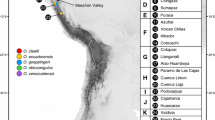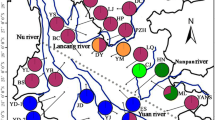Abstract
The Japanese spined loach Cobitis biwae includes the tetraploid form, which has 96 chromosomes, as well as the diploid form, which has 48 chromosomes. In the present study, we analyzed the mitochondrial DNA (mtDNA) to examine the genetic relationships among 82 populations of diploid–tetraploid complexes of C. biwae. Restriction fragment length polymorphism (RFLP) analysis of the ND1 region on 202 individuals revealed that C. biwae contains three genetically divergent major groups corresponding to geographical proximities (the Eastern, Western, and Kochi groups). Phylogenetic analyses (neighbor-joining, NJ and maximum-parsimony, MP) of a part of the cytochrome b gene sequence (748 bp) in 31 individuals supported the three major groups recognized by RFLP, and indicated considerable genetic differentiation between the Western group and the other two groups (average, 15.2%). The genetic relationship and distribution pattern of the three major groups hypothesized two major dispersions of C. biwae during the middle Miocene: first, the ancestor of the Eastern and Kochi groups had spread from the West through wide regions of present-day Honshu and Shikoku Islands, and following that period, the ancestor of the Western group with a different mtDNA composition, probably resulting from the mtDNA introgression from C. takatsuensis, moved into western Japan and pushed the former north eastward. All tetraploid form populations were included in the Western group and treated as a monophyletic cluster with low genetic divergence. It is notable that two diploid populations geographically adjacent to the tetraploid range were genetically closely related to the tetraploid forms. This result suggests that these diploid populations were directly related to the maternal origin of the tetraploid form.
Similar content being viewed by others
Author information
Authors and Affiliations
Corresponding author
About this article
Cite this article
Kitagawa, T., Watanabe, M., Kitagawa, E. et al. Phylogeography and the maternal origin of the tetraploid form of the Japanese spined loach, Cobitis biwae, revealed by mitochondrial DNA analysis. Ichthyol Res 50, 318–325 (2003). https://doi.org/10.1007/s10228-003-0174-6
Received:
Accepted:
Issue Date:
DOI: https://doi.org/10.1007/s10228-003-0174-6




